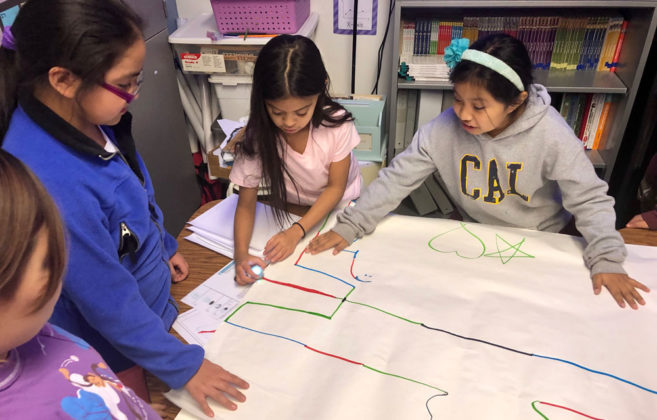“Why are you here? It’s not Friday!” remarked a fourth-grader in Allison’s Diaz’s class at Godfrey Elementary. She was addressing Sarah Wood, technology and media integration specialist for the district. Wood makes the rounds to classrooms, teaching science, technology, engineering, art and mathematics, or STEAM. It was unusual for her to be there on a Wednesday.
On this particular morning, Wood and Diaz had a surprise for the class.
“Today, you guys are going to be coders,” Wood announced.
The “day of code” was planned in tandem with the worldwide Hour of Code, an annual event designed to introduce students to coding and broaden interest in computer science.
“You need to understand that computers and robots are only as smart as you tell them to be,” Wood told the class. “They rely on you to give them directions.”

Algorithm is gonna get you
The students began by writing down directions — “algorithms”, Wood told the class — for brushing teeth. When fourth-grader Josiah Sutton-Tate put his algorithm to the test on Becky Quigley, the school nurse who followed his commands using her best robot voice, he got a lesson in how precise these directions needed to be. Hilarity ensued: Forgetting to say, “remove cap” or negating a command to stop gurgling or spitting could really throw things off.
After revising directions — “Mine are very specific; I have 20 steps,” said Audrianna Waddell — fourth-graders tried the exercise again, with greater success.
Marc Petz, 3D animation and game design instructor at Kent Career Tech Center, stopped by to show the class some of the work he does, including creating video games and apps.
Petz explained that math and words build programming language.
“What’s that ‘a’-word?” Wood asked the class again. “Alabra? Acabrimim?” came the answers before she nudged them toward ‘algorithm.’”
Other activities included math exercises, finding the binary equivalent of letters and “coding” names on a beaded necklace, a dance party, and making tiny codable robots known as Ozobots walk the runway for a fashion show.
Taking the fear out of coding
Wood attended the International Society for Technology and Education’s “No Fear Coding Lab” in October, an experience that got her thinking about planning a day of code.
While at the conference, she said, she heard many statistics about women and particularly women of color and coding. It brought her back to when she was often the only female in her college computer science classes. She hopes that early exposure can remove barriers for students, and help them see that anyone can master the lessons required to code.
“The underlying thing isn’t really coding,” she added. “It’s computational thinking. Can you take a big problem and break it down into smaller parts? Can you write an algorithm to solve a problem?”
Wood said Diaz’s class was a great choice for the activities because her students love to code, and because Diaz understands that the lessons are about so much more than coding.
Diaz said her students stumbled across the link to code.org on her classroom website early in the school year, and began to play around with it. Soon, most of the class was excited about coding with zero instruction or urging on her part.
“That was really cool to see them be so excited and figure it out on their own,” said Diaz, who incorporates coding into math and reading lessons.

The struggle is real. And necessary.
At one point during the day, students were visibly perplexed with a coding activity that required solving a math problem to make a path to the robot Wall-E on a paper grid.
Afterward, Wood told the class: “Part of me wanted you to struggle through it. Not because I’m mean. I understand your frustration, but we are coders, and you were doing a good job of asking questions and working through that frustration.”
Diaz reminded her students that they learn when they do things the wrong way, and that it’s a good thing when their brains hurt a little — it means they’re growing.
Before lunch, the students got a “brain break” to dance and move to an animated video. After, Wood asked them what they noticed about the video.
“It gave instructions!” said one student.
“And another word for instructions…that ‘a” word?” asked Wood.
Algorithms.
CONNECT












